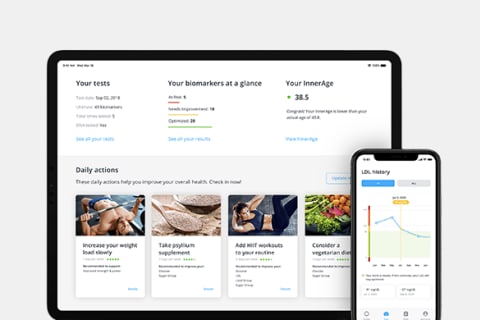But most of what I know about nutrition is based on either anecdotal personal experiences (that time I tried and failed at keto) or simple internet research—neither of which are precisely optimal in determining the perfect diet for my body and lifestyle. So when I learned there was an opportunity to dig deeper with InsideTracker and their revolutionary approach to personalized nutrition, I begged my editor to let me try it out. A few days later, my results were waiting for me in my inbox. Forty-three biomarkers—from nutrients like magnesium and vitamin D to cholesterol to hormones—painted a holistic picture of my overall health in a way that I’ve never had access to before. My results were neatly laid out to show where I was in relation to my personal “optimized zone”—a more precise range than merely “normal” zones, determined by my age, gender, ethnicity, and activity level. For years I was under the impression that as long as I was eating enough complete protein sources, healthy fats, and plenty of leafy greens, I was fueling my body “adequately.” It turns out, “adequate” isn’t exactly synonymous with “optimal”—and I’ll probably never view my nutrition this way again. By combining my blood analysis with additional genetic data from InsideTracker’s DNA Kit provided more precise recommendations because it harnessed the power of both my genetic potential and real-time blood data. I am definitely someone who fits into this camp, a fact that became clear from my InsideTracker results. It turns out my liver enzyme group—fueled by my high levels of ALT, AST, and GGT—might be at risk. According to InsideTracker R.D. Ashley Reaver, “These enzymes naturally exist in the liver and seep into the bloodstream when there is damage.” Luckily, my InsideTracker results had plenty of suggestions, including reducing my sugar consumption (good thing the holidays are over), taking a daily probiotic, and adding things like wheat germ to my diet. Still, there’s one more factor I had never even considered—taper down my resistance training. You read that right—it turns out it is possible to overtax your muscles (are you listening, gym rats?), and doing so can significantly increase your liver function labs1. So while I’ve long relied on a routine that sometimes has me hitting the weights seven days a week, this was the wake-up call I needed to rethink how I optimize my training for overall health. On the other side of the optimized zone, you’ll find my vitamin D. Shocker, I know—a year spent primarily indoors has caused my vitamin D levels to plummet (and there’s a good chance yours have as well). Ashley says this could be causing some fatigue in my workouts, especially those marathon resistance-training sessions. According to her, “Vitamin D is not only important for immune health but also plays a role in performance. It can increase muscle power and stimulate muscle growth since it is associated with optimal testosterone production.” And while you can get vitamin D from foods like fish and dairy, she says getting my levels back to normal requires something a little more substantial than a diet tweak—supplementing with 5,000 IUs per day for a few weeks should do the trick. So perhaps 2021 is the year I finally optimize my healthspan as well. According to my InsideTracker recommendations, there are plenty of ways I can go about adding more life to my years and years to my life —and you can too! My Action Plan included five concrete nutrition and lifestyle recommendations to follow; while personalized to my results, they may serve as a friendly reminder of practices we could all be following: Won’t you join me?




